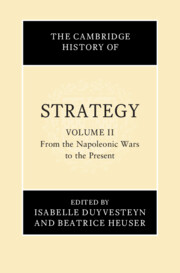Book contents
- The Cambridge History of Strategy
- The Cambridge History of Strategy
- The Cambridge History of Strategy
- Copyright page
- Dedication
- Contents
- Maps
- Contributors to Volume II
- Preface and Acknowledgements
- Introduction to Volume II
- 1 The Strategies of the Napoleonic Wars
- 2 Guerrilla and Nineteenth-Century Strategies of Insurgency
- 3 Russia, 1877–1917
- 4 The American Civil War
- 5 The Use of Naval Power
- 6 The Russo-Japanese War
- 7 Chinese Strategy, 1926–1949
- 8 First World War
- 9 Soviet Strategy, 1917–1945
- 10 Air Power
- 11 The Second World War in Europe
- 12 The Second World War in the Asia–Pacific
- 13 Soviet Strategy, 1945–1989
- 14 People’s War and Wars of Decolonisation
- 15 Nuclear Strategies
- 16 America’s Way of War
- 17 The Korean War
- 18 Israel’s Wars
- 19 The India–Pakistan Confrontations
- 20 The Yugoslav War, 1991–1999
- 21 Terrorism and Insurgency
- 22 The Forty-Year War in Afghanistan
- 23 The Three Gulf Wars and Iraq
- 24 China’s Wars, 1950–2021
- Conclusion
- Further Reading
- Index
7 - Chinese Strategy, 1926–1949
Published online by Cambridge University Press: 06 January 2025
- The Cambridge History of Strategy
- The Cambridge History of Strategy
- The Cambridge History of Strategy
- Copyright page
- Dedication
- Contents
- Maps
- Contributors to Volume II
- Preface and Acknowledgements
- Introduction to Volume II
- 1 The Strategies of the Napoleonic Wars
- 2 Guerrilla and Nineteenth-Century Strategies of Insurgency
- 3 Russia, 1877–1917
- 4 The American Civil War
- 5 The Use of Naval Power
- 6 The Russo-Japanese War
- 7 Chinese Strategy, 1926–1949
- 8 First World War
- 9 Soviet Strategy, 1917–1945
- 10 Air Power
- 11 The Second World War in Europe
- 12 The Second World War in the Asia–Pacific
- 13 Soviet Strategy, 1945–1989
- 14 People’s War and Wars of Decolonisation
- 15 Nuclear Strategies
- 16 America’s Way of War
- 17 The Korean War
- 18 Israel’s Wars
- 19 The India–Pakistan Confrontations
- 20 The Yugoslav War, 1991–1999
- 21 Terrorism and Insurgency
- 22 The Forty-Year War in Afghanistan
- 23 The Three Gulf Wars and Iraq
- 24 China’s Wars, 1950–2021
- Conclusion
- Further Reading
- Index
Summary
Although the early part of the century involved the Nationalist Party (KMT) campaigns – the Northern Expedition (1926-28) – to reunify China after the collapse of the Qing Dynasty, the history of China’s military strategy in the twentieth century is largely dominated by the activities of the Chinese Communist People’s Liberation Army (PLA). Embroiled in the first civil war with the Nationalists and avoiding annihilation during the latter’s five encirclement campaigns (1927–1937), the PLA under Mao Zedong’s leadership began to develop some of the core ideas of Communist Chinese military strategy – People’s War, and Active Defense. During the anti-Japanese War of Resistance, the Communists and the Nationalists arrived at a temporary truce to fight Japanese invaders (1937–1945). This period was largely marked by stalemate, but still involved millions of casualties, the use of guerrilla warfare, and the movement of millions of troops across China. Mao’s vision of military strategy unfolded with the resumption of the Communist–Nationalist civil war: guerrilla warfare; manoeuvre warfare; a hybrid of conventional and unconventional operations; conventional warfare; and then a war of annihilation, culminating in the Nationalist retreat to Taiwan.
- Type
- Chapter
- Information
- The Cambridge History of Strategy , pp. 142 - 155Publisher: Cambridge University PressPrint publication year: 2025

